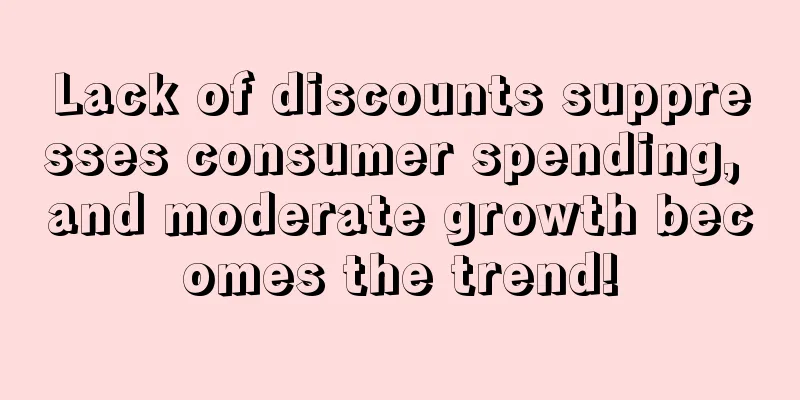Lack of discounts suppresses consumer spending, and moderate growth becomes the trend!

|
According to the latest news, due to rising inflation rates, consumers are finding it difficult to find previous promotions and discounts this holiday shopping season , resulting in a situation where "consumers save more and spend less . "
According to the U.S. Commerce Department, retail sales rose 0.3% from November but fell short of expectations, and the trend of modest growth suggests that consumer spending will be hit harder by inflation in the future , which is currently at a 39-year high . Last week, the U.S. Labor Department reported that the consumer price index rose 6.8% year-on-year in November, the fastest increase since June 1982.
According to foreign media reports, on an annual basis, retail sales in November this year increased by 18.2% year-on-year, while in October it increased by 16.3% year-on-year, as stimulus checks and wage increases supported consumer spending power. Online sales were unchanged last month, while department store sales fell 5.4%.
The report said that the "side effects" of the epidemic have reduced discounted items, while supply chain backlogs and inflation are some of the factors leading to the lack of discounts.
The report also said that retailers have faced discounting and deflation for years, and now their newfound pricing power is helping to increase profits at a time when retail sales are still recovering from the pandemic and price increases are also making shoppers think twice about where they spend this holiday season.
Data from the U.S. Bureau of Labor Statistics also showed that the producer price index in November increased 9.6% from the previous year and increased 0.8% month-on-month.
Some large brand companies in the United States are also raising prices. In addition to passing on higher prices to consumers, they are also recruiting employees amid labor shortages to ensure that the supply chain continues to be supported and shelves are stocked. The emergence of Omicron may exacerbate this situation.
Still, the National Retail Federation, the largest U.S. retail trade group, said that despite the challenges, the holiday shopping season appears on track to exceed its sales growth forecast of 8.5% to 10.5%. Holiday sales in 2020 were up 8.2% compared with the previous year .
With only one week left until Christmas, major retailers and sellers are preparing for the "final battle". Some are looking forward to it, while others say that they will be content as long as they don't lose money, and sales must continue whether they are good or bad. Discount lack |
<<: Five major development trends of DTC e-commerce in 2022
>>: Anker's new move! Investing 32 million to develop new product categories
Recommend
Selling goods is getting harder and harder! Shenzhen sellers turn into headhunters
In the cross-border circle, it is not a new thing...
What is Noah's Dream? Noah's Dream Review, Features
Fujian Noah Chuangmeng E-commerce Co., Ltd. was e...
Breaking the record! A "Star Wars" prototype doll sold for $1.342 million on eBay's Goldin
Recently, a rare 1979 version of " Star Wars...
What is Vide Dressing? Vide Dressing Review, Features
Vide Dressing is the first C2C second-hand clothin...
Employees can also be "bosses"! There are many tricks to retain cross-border talents
There is always a shortage of excellent people, a...
Foreign media: SHEIN is accused of deliberate trademark infringement and faces lawsuits from multiple independent station brands
On June 15, according to foreign media reports, s...
The product recall rate in the United States hit a ten-year high! Five major categories became the "hardest hit areas"
Recently, Sedgwick Brand Protection Company relea...
Domestic chip orders surge, supply exceeds demand, manufacturers announce price increases
Since yesterday, the topic #Domestic chip orders ...
The top 100 most valuable global retail brands in 2021 are released, with Amazon still ranking first
Amazon continued its dominance in e-commerce as t...
What is Ayen Entegrator? Ayen Entegrator Review, Features
<span data-docs-delta="[[20,{"gallery"...
What is Sinopolsk Shipping Company? Sinopolsk Shipping Company Review, Features
Founded on June 15, 1951, China-Polish Steamship ...
Amazon's multi-site warehouses are overwhelmed, are sellers facing another wave of returns?
Finally, the warehouse went bankrupt! After ONT8 ...
A batch of sellers' shipments were rejected
Last week, Amazon's two-day Prime Day came to...
Graphics card prices double as cryptocurrency mining surges in South Korea
With the rapid development of the virtual currenc...
Fan Bingbing enters cross-border business! A large number of talented people are going overseas
A gathering of big names ...the cross-border e-co...









